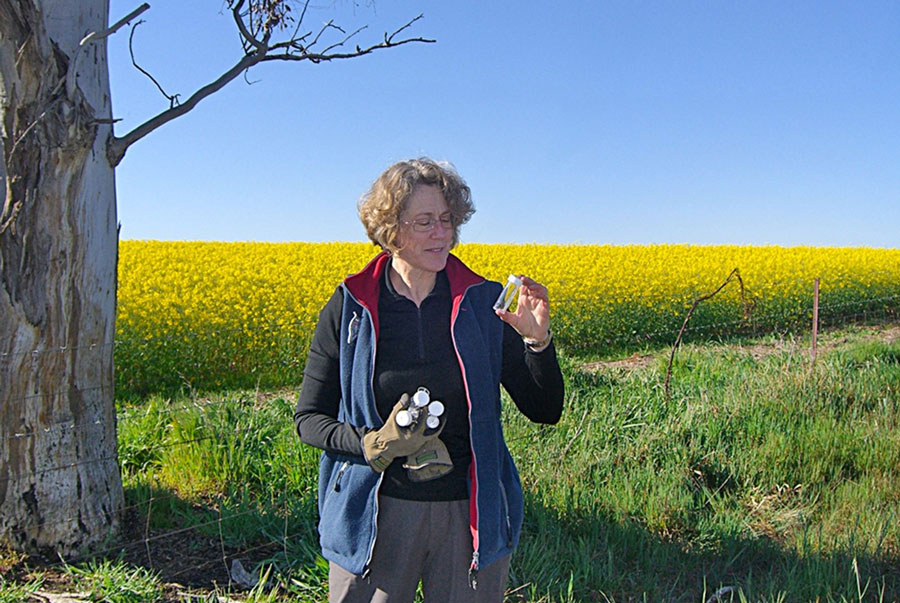Key points
- Snails and slugs are significant economic pests of grain crops and until now have been controlled by molluscicides
- The main molluscicide used is metaldehyde and its use may be restricted in Australia due to concerns about toxicity to mammals and birds
- A chance observation of a natural parasite in a captive slug population has led to the development of a novel biocontrol agent
A chance finding by an observant scientist has led to the discovery of a potential new biocontrol method for pest slugs and snails.
Scientists researching the biology and ecology of grey field slugs (Deroceras reticulatum) as a precursor to developing biocontrols, were trying to breed them in the laboratory, but found the slugs kept dying.
Closer examination revealed parasitic protozoa were killing them. Protozoa are microscopic single-celled organisms. This particular one was a ciliate protozoan, meaning it was covered in hairs (called cilia). The protozoan, Tetrahymena rostrata, is a natural parasite of slugs and snails; it occurs naturally in Australia and other parts of the world.
GRDC then invested in a new project with the University of Melbourne aimed at using T. rostrata as a biopesticide. The Melbourne team focused its efforts on the major pest, the grey field slug; however, recent experiments showed the protozoan can kill several species of slug and the effects on snails are also being evaluated. This means that the protozoan’s potential as a biocontrol agent may be far-reaching.
Snails and slugs are major crop pests, damaging plant seeds, seedlings, underground tubers, leaves and fruit.
Metaldehyde has been the molluscicide of choice for many years, commonly applied in pelleted baits. However, the use of metaldehyde may be restricted in the future due to concerns about its toxicity to mammals and birds.
Pesticide stewardship programs aim to reduce the need for metaldehyde but more options are needed for mollusc control. Researchers at the Asia Pacific Centre for Animal Health at the University of Melbourne are finding innovative ways to fight pest slugs and snails.

Associate Professor Helen Billman-Jacobe collecting slugs and snails in Wagga Wagga, NSW. Photo: Mike Dyall-Smith, The University of Melbourne
Insight and observation
Despite the importance of terrestrial molluscs, including grey field slugs, in agriculture and horticulture, their biology and ecology are relatively poorly understood. This is why the scientists were testing whether they could use genetic technology to shut down slugs’ metabolisms. They required a regular supply of slugs for laboratory testing, so started breeding grey field slugs (D. reticulatum) in the laboratory.
Collecting grey field slugs from the wild for experiments is labour-intensive, subject to seasonal availability, and there is a lot of variation in the health of collected animals. Colonies of laboratory-reared D. reticulatum were established to provide a predictable supply of animals for experiments, but then the protozoan T. rostrata became a factor.
T. rostrata cells go through several stages of development and can be either parasitic or free-living. Their life cycle has been exploited by researchers, who have now developed scalable production of the free-living form, and determined which developmental form is the most infective.
Researcher Dr Ruth Haites has studied the life cycle closely and can grow the cells in large numbers and then stimulate them to form cysts, allowing them to survive outside the host. These cysts are then primed to release the most infective protozoa.
Laboratory trials show T. rostrata kills young slugs within days of exposure. When the protozoa exit their cysts, they find a slug and kill it.
Testing and scaling up
The research group is undertaking host range and safety testing and is scaling up production to start the next phase of trials. The group aims to have products on the market in the next few years.
The best time to apply the protozoa to the soil needs to be determined, but it is predicted that it will be in autumn and spring when large numbers of slug and snail eggs hatch and the molluscs are still on the ground.
More information: Associate Professor Helen Billman-Jacobe, 03 8344 5698, hbj@unimelb.edu.au

























































